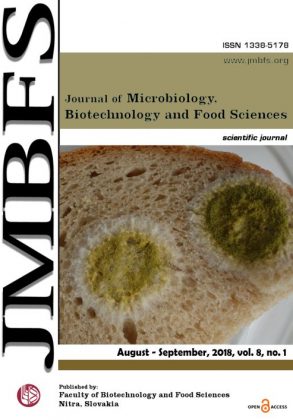EXTRACTION OF POLYSACCHARIDES FROM OPUNTIA CACTUS FOR ITS POTENTIAL APPLICATION IN EDIBLE COATING TO IMPROVE THE SHELF LIFE OF CITRUS (KINNOW MANDARIN) FRUIT
DOI:
https://doi.org/10.15414/jmbfs.2018.8.1.745-750Keywords:
Citrus, Edible coating, Cactus, Polysaccharides, Post-harvest lossesAbstract
Fruits and vegetables are subjected to post-harvest losses due to high moisture contents along with other physiological factors. Among various measure to control loses, development of edible coatings has been an imperative and innovative technique to achieve the desired goal. Opuntia cactus, a xerotrophyte, plant contains appreciable amount of polysaccharides thus can be utilized in edible coating formation. The mandate of present study was to extract polysaccharides from cactus for development of edible coatings for their potential applications on citrus fruits. For the purpose, various concentrations of extracted cactus polysaccharides were used to develop edible coatings. These coating were applied on citrus fruits (Kinnow mandarin) which were then stored for period of 35 days. The results indicated that the maximum moisture was observed in T3 (2% cactus polysaccharides) i.e. 86.94±2.10%. The maximum value for pH of coated citrus was found in T1 (3.19% cactus polysaccharides) as 3.19±0.02%. Conclusively, as the demand of fresh looking fruits and vegetables is increasing due to the awareness among the masses, edible coatings using cactus polysaccharides can play an imperative role in increasing the shelf life along with retaining the quality of various commodities.Downloads
Download data is not yet available.
Downloads
Published
2018-08-01
How to Cite
Riaz, S., Leonidovna Kleymenova, N., Sergeevna Kosenko, I., Ali Shariati, M., Bilal Hussain, M., Shabir Ahmad, R., Imran, M., Sibt-e-Abass, M., Tauseef Sultan, M., & Nikolaevna Egorova, G. (2018). EXTRACTION OF POLYSACCHARIDES FROM OPUNTIA CACTUS FOR ITS POTENTIAL APPLICATION IN EDIBLE COATING TO IMPROVE THE SHELF LIFE OF CITRUS (KINNOW MANDARIN) FRUIT. Journal of Microbiology, Biotechnology and Food Sciences, 8(1), 745–750. https://doi.org/10.15414/jmbfs.2018.8.1.745-750
Issue
Section
Food Sciences
License
Copyright (c) 2018 Sara Riaz, M. Tauseef Sultan, Muhammad Sibt-e-Abass, Muhammad Imran, Rabia Shabir Ahmad, Muhammad Bilal Hussain, Mohammad Ali Shariati, Inna Sergeevna Kosenko, Natalia Leonidovna Kleymenova, Galina Nikolaevna Egorova

This work is licensed under a Creative Commons Attribution 4.0 International License.
All papers published in the Journal of Microbiology, Biotechnology and Food Sciences are published under a CC-BY licence (CC-BY 4.0). Published materials can be shared (copy and redistribute the material in any medium or format) and adapted (remix, transform, and build upon the material for any purpose, even commercially) with specifying the author(s).





